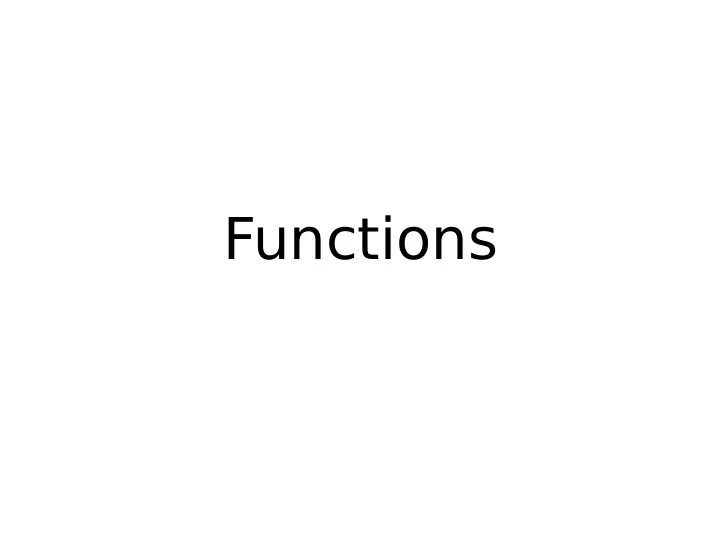

Functions
Making a function Yes, we’re going to count letters again. A solution yesterday’s #1 (except for the raw_input) seq = "ATGCATGATGCATGAAAGGTCG" counts = {} for base in seq: if base not in counts: counts[base] = 1 else: counts[base] = counts[base] + 1 for base in counts: print base, “=”, counts[base]
Identify the function I’m going to make a function which counts bases. What’s the best part to turn into a function? seq = "ATGCATGATGCATGAAAGGTCG" counts = {} for base in seq: if base not in counts: counts[base] = 1 else: counts[base] = counts[base] + 1 for base in counts: print base, “=”, counts[base]
Identify the input In this example the sequence can change. That makes seq a good choice as a parameter. seq = "ATGCATGATGCATGAAAGGTCG" counts = {} for base in seq: if base not in counts: counts[base] = 1 else: counts[base] = counts[base] + 1 for base in counts: print base, “=”, counts[base]
Identify the algorithm This is the part of your program which does something. seq = "ATGCATGATGCATGAAAGGTCG" counts = {} for base in seq: if base not in counts: counts[base] = 1 else: counts[base] = counts[base] + 1 for base in counts: print base, “=”, counts[base]
Identify the output The output will use the data computed by your function... seq = "ATGCATGATGCATGAAAGGTCG" counts = {} for base in seq: if base not in counts: counts[base] = 1 else: counts[base] = counts[base] + 1 for base in counts: print base, “=”, counts[base]
Identify the return value ... which helps you identify the return value seq = "ATGCATGATGCATGAAAGGTCG" counts = {} for base in seq: if base not in counts: counts[base] = 1 else: counts[base] = counts[base] + 1 for base in counts: print base, “=”, counts[base]
Name the function First, come up with a good name for your function. It should be descriptive so that when you or someone else sees the name then they have an idea of what it does. Good names Bad names do_count count_bases count_bases_in_sequence count_letters CoUnTbAsEs countbases QPXT
Start with the ‘def’ line The function defjnition starts with a ‘ def ’ def count_bases(seq): I t takes one parameter, It is named which will be accessed ‘ count_bases ’ using the variable named ‘ seq ’ Remember, the def line ends with a colon
Add the code block def count_bases(seq): counts = {} for base in seq: if base not in counts: counts[base] = 1 else: counts[base] = counts[base] + 1
Return the results def count_bases(seq): counts = {} for base in seq: if base not in counts: counts[base] = 1 else: counts[base] = counts[base] + 1 return counts
Use the function def count_bases(seq): counts = {} for base in seq: if base not in counts: counts[base] = 1 else: counts[base] = counts[base] + 1 return counts input_seq = “ATGCATGATGCATGAAAGGTCG” results = count_bases(input_seq) for base in results: print base, “=”, counts[base]
Use the function Notice that the variables def count_bases(seq): for the parameters and counts = {} the return value don’t for base in seq: need to be the same if base not in counts: counts[base] = 1 else: counts[base] = counts[base] + 1 return counts input_seq = “ATGCATGATGCATGAAAGGTCG” results = count_bases(input_seq) for base in results: print base, “=”, counts[base]
Interactively >>> def count_bases(seq): ... counts = {} ... for base in seq: ... if base not in counts: ... counts[base] = 1 ... else: ... counts[base] = counts[base] + 1 ... return counts ... (I don’t even need a >>> count_bases("ATATC") variable name - just use {'A': 2, 'C': 1, 'T': 2} the values directly .) >>> count_bases("ATATCQGAC") {'A': 3, 'Q': 1, 'C': 2, 'T': 2, 'G': 1} >>> count_bases("") {} >>>
Functions can call functions >>> def gc_content(seq): ... counts = count_bases(seq) ... return (counts["G"] + counts["C"]) / float(len(seq)) ... >>> gc_content("CGAATT") 0.333333333333 >>>
Functions can be used (almost) anywhere In an ‘if’ statement >>> def polyA_tail(seq): ... if seq.endswith("AAAAAA"): ... return True ... else: ... return False ... >>> if polyA_tail("ATGCTGTCGATGAAAAAAA"): ... print "Has a poly-A tail" ... Has a poly-A tail >>>
Functions can be used (almost) anywhere In an ‘for’ statement >>> def split_into_codons(seq): ... codons = [] ... for i in range(0, len(seq)-len(seq)%3, 3): ... codons.append(seq[i:i+3]) ... return codons ... >>> for codon in split_into_codons("ATGCATGCATGCATGCATGC"): ... print "Codon", codon ... Codon ATG Codon CAT Codon GCA Codon TGC Codon ATG Codon CAT >>>
Exercise A Make a function to add two numbers. Use the following as a template for your program def add(a, b): # ... your function body goes here print "2+3 =", add(2, 3) print "5+9 =", add(5, 9) The output from your program should be 2+3 = 5 5+9 = 14
Exercise B Modify your program from Exercise A to add three numbers. Use the following as a template for your new program def add3 # you must finish this line # then fill in the body print "2+3+4 =", add(2, 3, 4) print "5+9+10 =", add(5, 9, 10)
Exercise C Use the count_bases function defjned earlier and ask for a sequence using raw_input then printed the result.
Recommend
More recommend